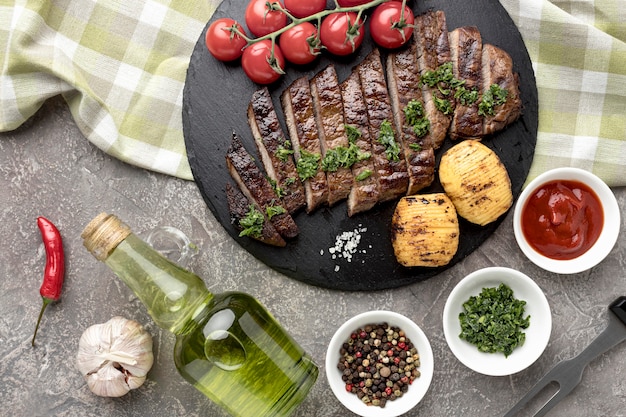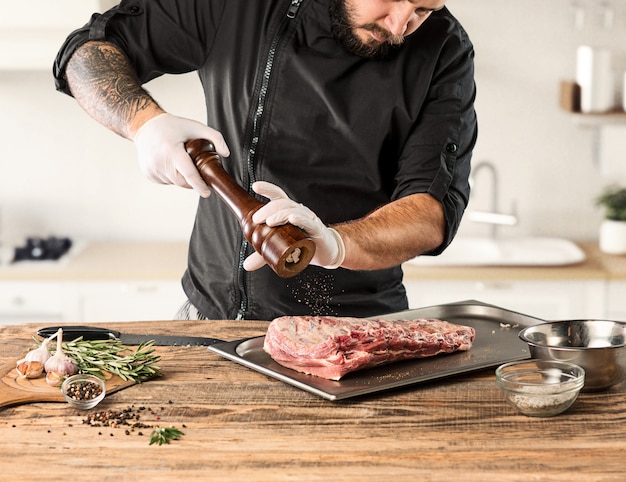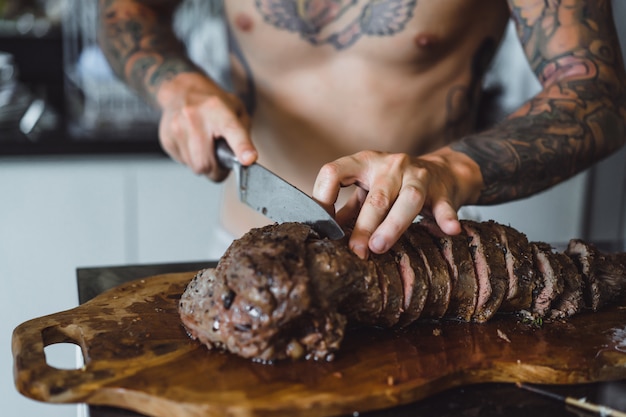There's a certain magic to a perfectly cooked steak, isn't there? The alluring sizzle as it hits the pan, the intoxicating aroma that fills your kitchen, and finally, that first bite, a symphony of textures and flavors that explodes in your mouth. It's pure culinary bliss. But achieving that level of perfection isn't always easy. You've probably had your share of dry, tough, or even raw steak disasters, haven't you? I certainly have! I've spent years in the kitchen, experimenting, learning, and perfecting my own steak game. And today, I'm here to share all my secrets, so you can finally unlock the secrets of the perfect steak.
(Part 1) The Steak

choosing the right cut: The Canvas for Your steak masterpiece
Let's start with the foundation - the cut of meat itself. Choosing the right cut is like selecting the perfect canvas for your masterpiece. It sets the stage for the flavors and textures you'll achieve. Each cut has its unique characteristics, its own story to tell. Let's delve into some of the most popular options:
- Ribeye: Ah, the ribeye! This is the king of steaks, known for its luxurious marbling, giving it an incredibly juicy and flavorful profile. This cut practically melts in your mouth, making it a true indulgence. Think of it as the decadent, buttery steak experience.
- new york strip: A classic choice, the New York Strip strikes a beautiful balance between fat and lean, resulting in a steak that's both tender and flavorful. It's a versatile cut, making it ideal for a variety of cooking methods.
- filet mignon: This is the most tender cut, offering a delicate and refined flavour. It's the perfect choice for those who prefer a leaner, more subtle steak experience.
- Sirloin: A good all-around choice, the sirloin delivers good flavor and texture at a more budget-friendly price. It's an excellent option for everyday steak nights.
- flank steak: Lean and flavorful, the flank steak is a favourite for slicing after cooking. It's fantastic for grilling or stir-fries.
Now, I have a confession: I'm a sucker for a good ribeye. There's just something about the rich, buttery flavor that makes me weak in the knees. But honestly, the best cut for you depends entirely on your own taste and what you're looking for in a steak. Don't be afraid to experiment and discover your personal favourite!
Thickness Matters: It's Not Just About Aesthetics
The thickness of your steak isn't just about how it looks on your plate, it significantly impacts how it cooks. Think of it as the thickness of the canvas – a thicker canvas needs more time to dry, and a thinner one dries faster. Thicker steaks require longer cooking times and are better suited for slow cooking methods like grilling or pan-searing. Thinner steaks cook quickly and are perfect for pan-frying or stir-fries.
A general rule of thumb is to aim for a steak that's at least 1 inch thick for optimal results. This allows for a beautiful crust and ensures the interior cooks evenly.
(Part 2) Preparing Your Steak: The Pre-Game Ritual

Temperature is Key: Bringing Your Steak to Room Temperature
This is a crucial step, one I learned the hard way. Think about it this way: you wouldn't toss a frozen pizza straight into a hot oven, would you? The same principle applies to your steak! A cold steak will take longer to cook, leading to uneven cooking and a less-than-perfect result. So, let's talk about bringing your steak to room temperature.
Take your steak out of the refrigerator at least 30 minutes before cooking. This allows the steak to warm up evenly, ensuring a more consistent cook. It's a simple step, but it can make a world of difference in the final product.
Pat It Dry: The Final Touch-up
Think of this as the final touch-up before your masterpiece is unveiled. Patting your steak dry with paper towels before cooking is a crucial step. It ensures a crisp, even crust by removing excess moisture. Moisture can cause the steak to steam rather than sear, resulting in a dull, less appealing surface.
Remember, a dry steak is a happy steak! It's the key to a beautiful, golden-brown sear.
Seasoning: The Secret Weapon
Seasoning is where your steak really comes alive! But it's not just about throwing salt and pepper on it. It's about creating a flavour profile that enhances the steak's natural characteristics. Think of it as adding the finishing touches to your canvas, highlighting the colours and textures.
Here's a basic seasoning recipe that I swear by:
- Salt: Use coarse kosher salt. It provides maximum flavor and distributes evenly. Imagine it like a gentle brushstroke, adding subtle depth to your steak.
- Black Pepper: Freshly ground black pepper is always the best choice. It adds a pungent aroma and a satisfying bite to your steak. Think of it as a bold stroke of colour.
- Garlic Powder: A subtle touch of garlic powder adds an earthy dimension to the flavor. It's like a subtle shadow, deepening the flavour profile.
- Onion Powder: Onion powder enhances the savory notes of your steak, giving it an extra layer of complexity. Think of it as a complementary shade, bringing out the steak's natural beauty.
Less is often more when it comes to seasoning. Let the steak's natural flavors shine through. Just a simple blend can be all you need to create a memorable steak experience.
(Part 3) Cooking Your Steak: The Grand Reveal

Grilling: The Classic Method
Ah, the sizzle of a hot grill! It's a classic for a reason. Grilling imparts a smoky, chargrilled flavour that's hard to resist. But mastering the art of grilling requires a bit of technique and attention to detail.
- Preheat Your Grill: A hot grill is essential for a good sear, think of it as a hot canvas ready to be painted upon. Aim for a temperature of around 450-500°F (230-260°C).
- Use a Grill Brush: Clean your grill grate with a wire brush to remove any food residue. You wouldn't paint on a dirty canvas, would you?
- Oil the Grill: Lightly brush the grill grate with oil to prevent sticking. This is like priming your canvas, ensuring a smooth surface for the paint.
- Don't Overcrowd: Give your steaks space to breathe! Overcrowding the grill will prevent proper heat distribution, leading to uneven cooking. It's like spreading your paint too thinly, creating a dull result.
- Flip Once: Let the steak cook undisturbed for 2-3 minutes per side. Resist the urge to flip it multiple times! This will only prevent a good sear from forming. Think of it as allowing the paint to dry completely before adding another layer.
- Cook to Your Desired Doneness: Use a meat thermometer to check the internal temperature of your steak. This is like checking the wetness of the paint, ensuring it's ready for the next step.
Grilling is a dance between heat and time. Don't be afraid to experiment and find your perfect grilling rhythm.
Pan-Searing: A Speedy Option
Pan-searing is a fantastic option for those who prefer a quicker cooking method. It's also a great way to achieve a beautiful crust and juicy interior, even for thicker steaks. Think of it as a quick and vibrant brushstroke, creating a masterpiece in a short time.
- Heat Your Pan: Use a cast iron skillet or a heavy-bottomed pan for even heat distribution. Heat the pan over medium-high heat until it's very hot. Imagine it as a canvas prepared to receive the colours.
- Add Oil: Add a tablespoon of oil, like canola or grapeseed oil, to the hot pan. This is like choosing the right paint for your canvas, ensuring smooth and even application.
- Sear Your Steak: Place your steak in the hot pan and let it cook undisturbed for 2-3 minutes per side. Resist the urge to move it around too much! This will allow for a beautiful crust to form, like the initial strokes of your masterpiece.
- Reduce Heat: Reduce the heat to medium-low and continue cooking until the steak reaches your desired doneness. This is like gradually layering the colours, allowing them to blend and create depth.
The key to a good pan-sear is a hot pan and a patient hand. Let the steak develop a beautiful crust without interfering with its cooking process.
Oven Baking: For Those Who Love Control
Oven baking might not be the most glamorous method, but it's a great option for achieving consistent results, especially for thicker steaks. Think of it as a more controlled and methodical approach to painting, allowing you to build your masterpiece layer by layer.
- Preheat Oven: Preheat your oven to 400°F (200°C). This is like setting the temperature for your canvas, ensuring a consistent environment for drying.
- Season Your Steak: Season your steak liberally with salt, pepper, and any other desired spices. This is like applying the base coat to your canvas, setting the stage for the final details.
- sear steak: Sear the steak in a hot pan or on the grill for 2-3 minutes per side to develop a nice crust. This is like adding a bold layer of colour to your canvas, creating a striking effect.
- Place in Oven: Transfer the seared steak to a baking sheet and place it in the preheated oven. This is like placing your canvas in a controlled environment, allowing the paint to dry evenly.
- Cook to Doneness: Cook the steak until it reaches your desired doneness. The cooking time will vary depending on the thickness of your steak. This is like checking the wetness of the paint, ensuring it's ready for the final touches.
Oven baking offers a gentle and even cooking experience, allowing you to achieve a beautifully cooked steak without the stress of constantly monitoring the grill or pan.
(Part 4) Doneness Explained: Understanding the Language of Steak
Internal Temperatures: A Guide to Doneness
Doneness is a matter of personal preference. Some prefer their steak rare, while others prefer it well-done. But there's a science behind it, and understanding internal temperatures can help you achieve your desired level of doneness. It's like knowing the language of paint, understanding how different shades blend and create unique effects.
Here's a handy chart to guide you:
| Doneness | Internal Temperature (°F) | Internal Temperature (°C) |
|---|---|---|
| Rare | 125-130 | 52-54 |
| Medium-Rare | 130-135 | 54-57 |
| Medium | 140-145 | 60-63 |
| Medium-Well | 150-155 | 65-68 |
| Well-Done | 160 | 71 |
Remember, these are just guidelines. The actual internal temperature may vary slightly depending on the cut of steak, thickness, and your oven or grill's temperature. It's like understanding the nuances of paint, how different factors can impact the final result.
Using a Meat Thermometer: Your Steak's Best Friend
A meat thermometer is your best friend when it comes to achieving consistent results. It allows you to check the internal temperature of your steak without having to guess. Think of it as a precision tool, ensuring you achieve the perfect shade of your steak's internal colour.
Simply insert the thermometer into the thickest part of the steak, making sure it doesn't touch any bones. I always recommend using a digital meat thermometer for accuracy and speed. It's a worthwhile investment if you're serious about your steak game.
(Part 5) Resting Your Steak: The Final Touch
This step is often overlooked, but it's crucial for achieving the perfect steak. Resting allows the juices to redistribute throughout the steak, resulting in a more tender and flavorful piece of meat. It's like allowing your masterpiece to settle, allowing the colours to blend and create a harmonious whole.
Simply remove your steak from the heat and let it rest for 5-10 minutes before slicing and serving. It might seem like an eternity, but trust me, it's worth the wait. The juices will have a chance to settle, resulting in a more evenly cooked and juicy steak.
(Part 6) Slicing and Serving: Unveiling the Masterpiece
Now comes the exciting part! Slicing your steak is an art form, a final act of presentation, showcasing the beautiful marbling and texture. Think of it as carefully framing your masterpiece, highlighting its key elements.
- Use a Sharp Knife: A sharp knife is essential for clean, even cuts. It's like using a precise brush, creating clean lines and smooth transitions.
- Slice Against the Grain: Slicing against the grain helps tenderize the steak and makes it easier to chew. Think of it as working with the texture of the canvas, creating a smoother, more inviting surface.
- Slice Thinly: Thin slices allow the juices to be released more easily, creating a more flavorful experience. It's like revealing the hidden layers of your painting, showcasing its depth and complexity.
- Arrange Beautifully: Arrange your slices on a plate or platter. You can create a visually appealing presentation by fanning the slices or creating a neat stack. This is like carefully arranging your painting on a stand, drawing attention to its beauty and craftsmanship.
I love to serve my steak with a simple side of roasted vegetables or a creamy mashed potato. A sprinkle of fresh herbs adds a final touch of elegance and flavour, like the finishing touches of gold leaf or a delicate brushstroke.
(Part 7) Don't Be Afraid to Experiment: Your culinary journey
Remember, there's no one-size-fits-all approach to cooking the perfect steak. It's about discovering what works best for you, your personal preferences and culinary journey. Experiment with different cuts, cooking methods, and seasonings. Don't be afraid to try something new. The beauty of cooking is in the exploration, in finding your own unique style, like an artist discovering their own signature technique.
My favourite recent experiment? Adding a splash of balsamic vinegar to my pan-searing oil. The tangy flavour adds a touch of sweetness and complexity to the steak, like a bold splash of colour that enhances the overall composition of your masterpiece.
(Part 8) FAQs: Unlocking the Secrets of the Steak Master
Q1: How do I know if my steak is done?
The best way to tell if your steak is done is to use a meat thermometer. Insert the thermometer into the thickest part of the steak, making sure it doesn't touch any bones. Check the chart above for the recommended internal temperatures based on your desired doneness. You can also use the touch method, where you press on the steak to feel its firmness. However, this method is less reliable and should be used in conjunction with a thermometer.
Q2: What if my steak is overcooked?
Don't despair! Overcooked steak can still be salvaged. If your steak is overcooked, it's likely dry and tough. You can try slicing it thinly and adding it to a stir-fry or pasta dish. You can also try adding some sauce or gravy to moisten it and make it more flavorful.
Q3: What are some good steak sauces?
The possibilities are endless! A classic steak sauce is béarnaise sauce, which is a creamy, egg-based sauce with a tangy flavour. Other popular options include chimichurri sauce, a vibrant Argentinian herb sauce, and peppercorn sauce, which adds a spicy kick. Personally, I love a simple garlic butter sauce or a classic red wine reduction. Ultimately, the best sauce is the one that complements your steak and your taste preferences.
Q4: Can I marinate my steak?
Yes! Marinating your steak can add flavour and tenderness. A good marinade should include an acid, like vinegar or lemon juice, and a source of fat, like olive oil. You can also add herbs, spices, garlic, and even honey for added sweetness. Marinate your steak for at least 30 minutes, but ideally overnight for the best results. Just remember to pat your steak dry before cooking to ensure a good sear.
Q5: What are some good side dishes for steak?
Steak is versatile and pairs well with a wide range of side dishes. Some classic choices include mashed potatoes, roasted vegetables, grilled corn on the cob, and creamy asparagus. If you're feeling adventurous, try a salad with a vinaigrette dressing or a side of rice pilaf. The possibilities are endless!
Everyone is watching

Corn on the Cob: The Ultimate Guide to Perfectly Cooked Ears
Healthy MealsAh, corn on the cob. Just the name evokes images of sunny days, barbecues, and that sweet, juicy flavour that ...

Perfect Pork Roast Oven Cooking Time: A Guide to Delicious Results
Healthy MealsThere's something truly satisfying about a perfectly roasted pork. The aroma alone is enough to make your mout...

Scallops: The Ultimate Guide to Perfect Cooking
Healthy MealsAh, scallops. Those delicate, sweet, and utterly delicious morsels of the sea. They hold a special place in my...

Ham Cooking Time: How Long to Bake, Smoke, or Boil a Delicious Ham
Healthy MealsAh, ham. It's a classic, isn't it? A real crowd-pleaser, especially around holidays. And when done right, it'...

Spaghetti Squash: The Ultimate Guide to Cooking and Serving
Healthy MealsRemember that time you saw spaghetti squash at the supermarket, looking all bumpy and strange, and thought, "W...
